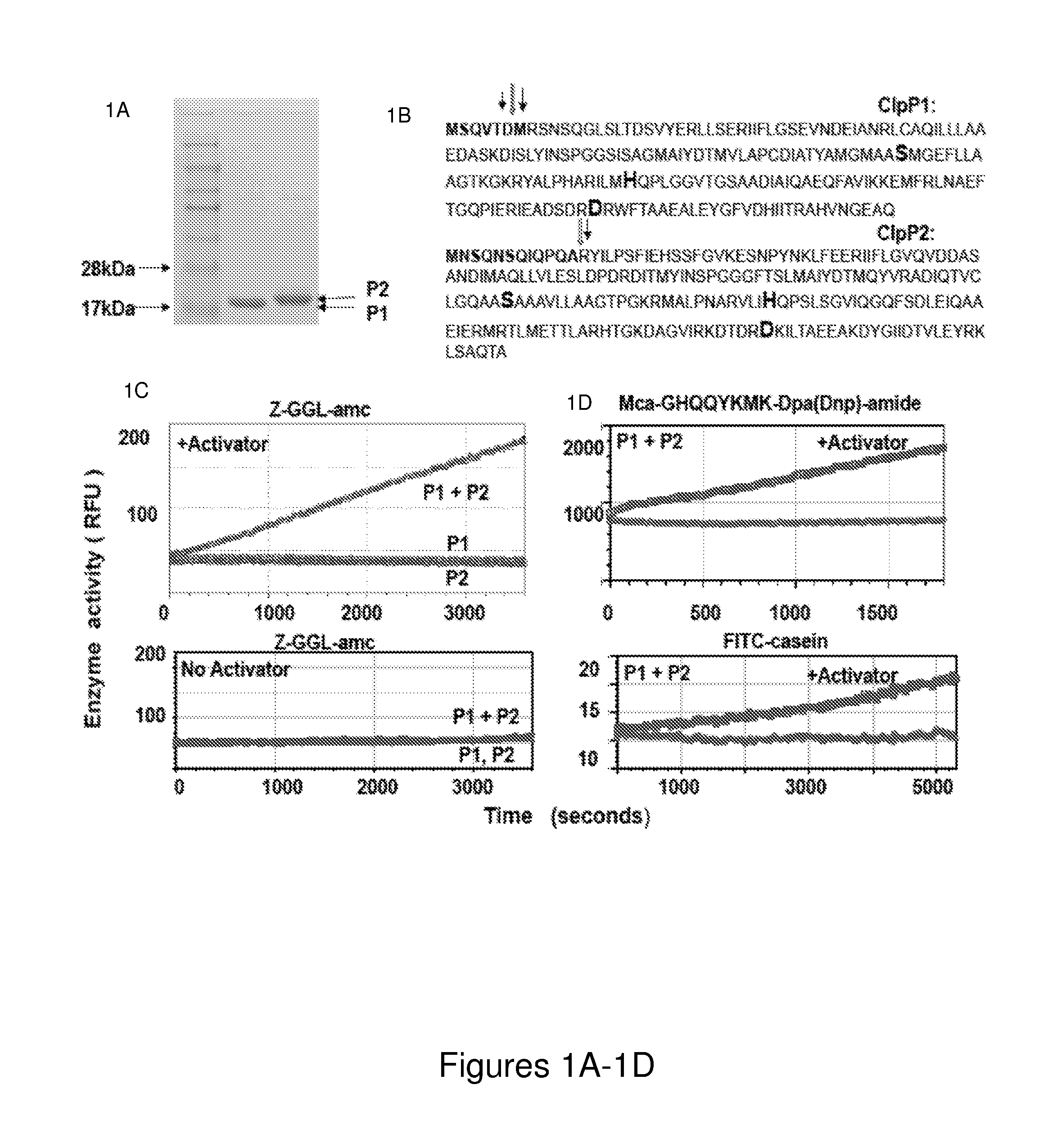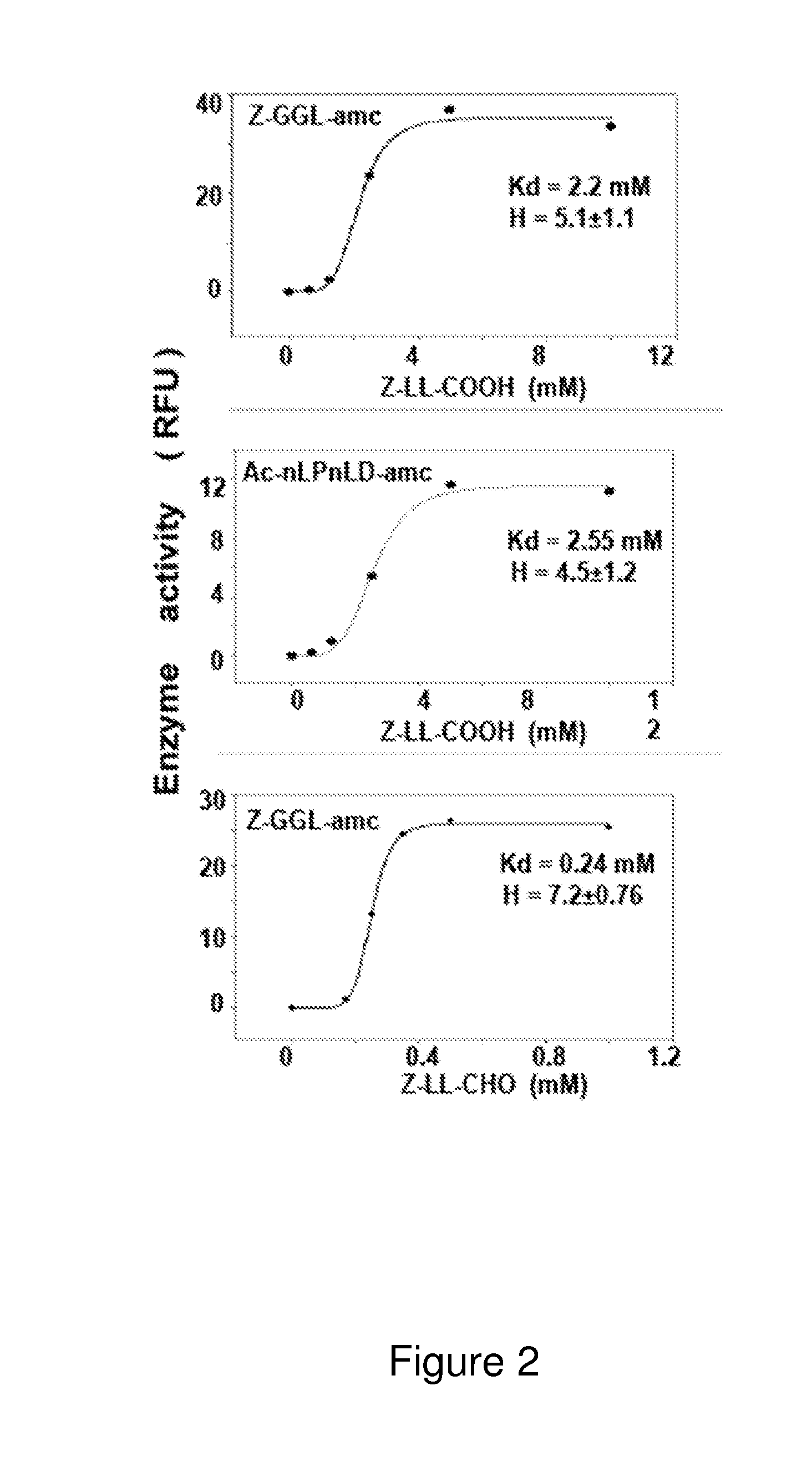Treatments for mycobacterium tuberculosis
- Summary
- Abstract
- Description
- Claims
- Application Information
AI Technical Summary
Benefits of technology
Problems solved by technology
Method used
Image
Examples
example 1
The Active ClpP Protease from Mycobacterium tuberculosis is a Complex Composed of a Heptameric ClpP1 and a ClpP2 Ring
[0268]Mtb contains two clpP genes, clpP1 and clpP2, both of which are essential for viability (Sassetti et al, 2003) and infectivity, as shown in Example 2. Although both appear to encode serine proteases, prior attempts (Benaroudj et al, 2011; Ingvarsson et al, 2007) to express and characterize Mtb ClpP1 and ClpP2 in E. coli yielded complexes that lacked proteolytic activity, as did our initial attempts to express ClpP1 and ClpP2 in E. coli. The inventors hypothesized that those attempts failed because they were based on the assumption that ClpP1 and ClpP2 are distinct enzymes, while in fact, the active enzyme in vivo is a mixed complex.
[0269]It is demonstrated herein that ClpP1 and ClpP2, when overproduced independently, form tetradecameric complexes that lack any proteolytic activity. However, when these complexes are mixed together in the presence of certain small...
example 2
In Mycobacterium tuberculosis, ClpP1 and ClpP2 Form a Single Protease Complex Essential for Viability and Virulence
[0377]In most bacteria, ClpP is a conserved, non-essential protease that regulates the response to various stresses. Mycobacterium tuberculosis (Mtb), unlike most prokaryotes, encodes two ClpP homologs, ClpP1 and ClpP2 in a single operon. A transposon-based mutagenesis screen for essential genes in Mtb predicted that ClpP2 and the ATPase adapters ClpC1 and ClpX, were required for normal growth (Sassetti et al., 2003). Through inducible expression of ClpP1 and ClpP2, it is demonstrated herein that both genes are essential for growth and that depletion of either subunit results in cell death. Also demonstrated herein is that the ClpP1P2 protease is required for the degradation of SsrA-tagged proteins. ClpP1P2 appears important in degrading missense and prematurely terminated peptides since partial depletion of ClpP2 reduced growth especially in the presence of antibiotics...
example 3
Cleavage Specificity Of Mtb ClpP1P2 Established Using Tripeptide Substrates Library (Ac-P3-P2-P1-Amc)
[0439]The ClpP1P2, essential enzyme in Mycobacterium tuberculosis (Mtb) is a potential drug target for the development of anti Mtb therapeutics. An N-acetyl trypeptide-aminomethylcoumarin (Ac-P3-P2-P1-amc) library was used to elucidate the preferable P1, P2 and P3 positions at cleavage sites.
[0440]Mtb ClpP1P2 was distinctive in preferring Met at P1 position, particularly in combination with Lys and Pro in P2 and P3 position correspondingly. Enzyme also cleaves (but less efficiently) the peptides containing Leu, Phe, Ala and in few cases Asp and Lys at P1 position (FIGS. 14A-14B, 15 and Table 7). Screening results were confirmed by synthesis and kinetic analysis of sixteen substrates. The determined Kcat / Km value indicates that indeed the enzyme prefers the peptide substrates possessing Met at P1, basic at P2 and Pro at P3. The new substrates identified in this study are up to 1000-fo...
PUM
 Login to View More
Login to View More Abstract
Description
Claims
Application Information
 Login to View More
Login to View More - R&D
- Intellectual Property
- Life Sciences
- Materials
- Tech Scout
- Unparalleled Data Quality
- Higher Quality Content
- 60% Fewer Hallucinations
Browse by: Latest US Patents, China's latest patents, Technical Efficacy Thesaurus, Application Domain, Technology Topic, Popular Technical Reports.
© 2025 PatSnap. All rights reserved.Legal|Privacy policy|Modern Slavery Act Transparency Statement|Sitemap|About US| Contact US: help@patsnap.com



